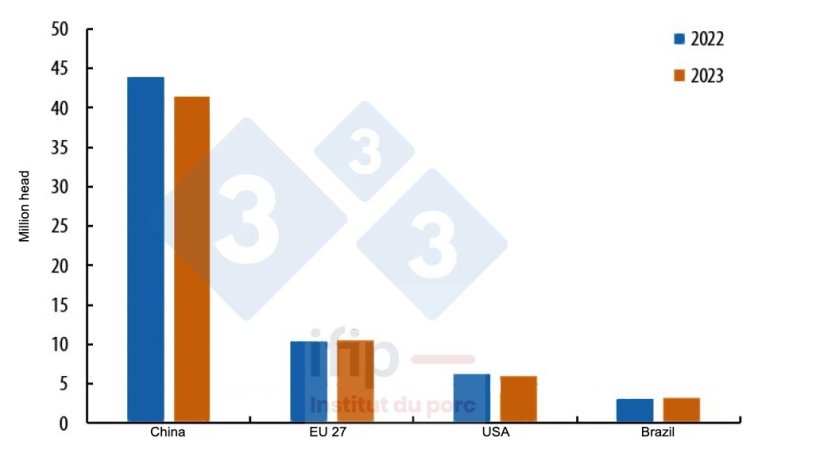In 2023, world pork production reached 115 million tons carcass equivalent (tce), an increase of 0.6% compared to 2022. This supply growth is linked to developments in China and Brazil, which offset the European decrease. International demand fell by 3.1% year on year.
In 2024, the outlook will depend on the dynamics of the largest producers (China, the European Union, the United States, and Brazil). World production is expected to fall slightly by -0.9% year-on-year while demand is expected to be higher. A slight fall in world pork supply is predicted, impacted by China, with a moderate recovery in international demand. European players will have to compete with the United States and Brazil amidst geopolitical, sanitary, commercial, regulatory, and social uncertainties.


Evolution of the breeding sow herd in the main world producers at the end of 2023/2022. Source: IFIP according to Eurostat, MoA, and USDA.
European Union
In the EU-27, the 2023 year-end livestock survey predicts a possible end to decapitalization. In 2023, the European supply fell 7.6% of slaughtered pigs, the equivalent of 17.3 million pigs. The slaughtering and cutting sector has been affected by restructuring which has consequences on the market. These reorganizations will limit European production at the beginning of the year. An improvement is expected in the second half. In 2023, exports fell sharply: sales of pork products to third markets decreased by 19% in volume. In addition to the drop in European production and availability for export, very low pork prices on the other side of the Atlantic have made U.S. and Brazilian pork more competitive internationally. Added to this was a currency disadvantage for the EU: the euro's strength against the dollar and the Brazilian real penalized European pork exports. In 2024, European exporters are expected to benefit from market opportunities, particularly in China, but competitiveness challenges remain. On the consumption side, inflation should ease.
China
In 2024, Chinese pork production is expected to decline by 3%, according to the USDA, due to difficulties in the domestic market: African swine fever and PRRS epidemics, and a challenging 2023 for the swine industry. Despite a promising start to 2024, China's economic fragility is hampering domestic demand, even during national holidays. A large supply in the face of low demand caused prices to fall sharply while farms, with high production costs, became unprofitable. As a result, the Chinese swine industry has suffered significant economic losses leading to a reduction of the national breeding sow herd to 41 million head by the end of 2023, an annual drop of 5.6%.
To counter this negative trend, China's Ministry of Agriculture announced a new plan to regulate domestic pork production capacity. The Chinese government wants to stabilize the number of breeding sows at 39 million head, adjusting numbers according to supply and demand. This plan calls for increased market and disease surveillance, with reinforced support from public administrations. Imports are expected to recover in 2024 to compensate for this drop in supply.
United States
After a difficult year in 2023 for the U.S. swine industry, a 2.4% recovery in production is expected for 2024 according to the USDA. Supply should be stimulated by domestic demand and exports. Despite the economic, health, and political challenges, U.S. analysts predict an improvement in production thanks to increased productivity and a recovery in demand. Considering the decrease in herds (-3.3% sows in December 2023/22), this USDA outlook seems optimistic. However, U.S. pork should maintain its competitiveness in the global market, with growth prospects in Central and South America.
Brazil
After a good year in 2023, production, exports, and consumption are expected to increase in 2024. Benefiting from a reduction in production costs following the fall in raw material prices and a dynamic export market, the Brazilian swine industry continues to prosper thanks to investments by manufacturers. The outlook for Brazil is therefore good, with both domestic and external demand improving.



